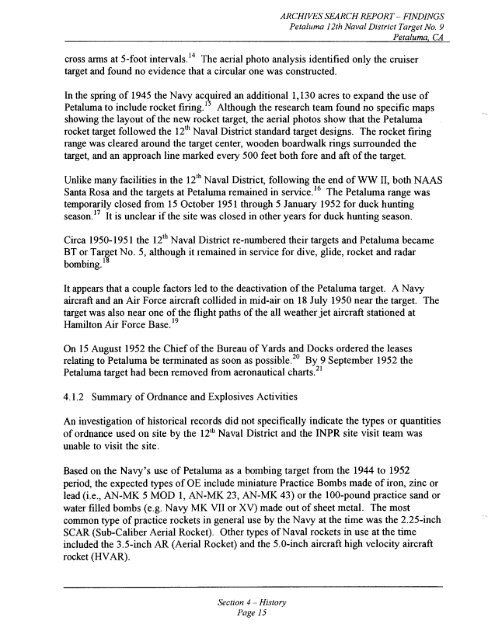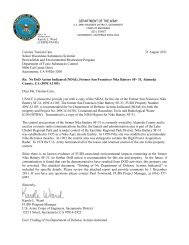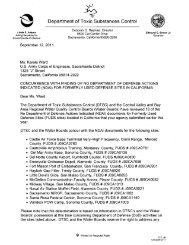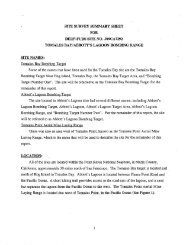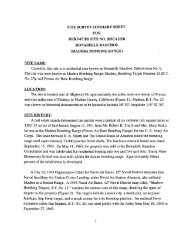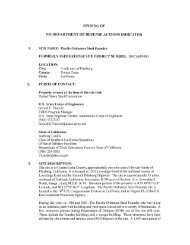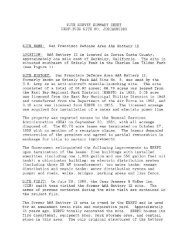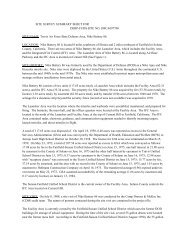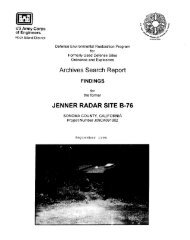Petaluma Bombing Target Archive Search Report ... - Corpsfuds.org
Petaluma Bombing Target Archive Search Report ... - Corpsfuds.org
Petaluma Bombing Target Archive Search Report ... - Corpsfuds.org
Create successful ePaper yourself
Turn your PDF publications into a flip-book with our unique Google optimized e-Paper software.
ARCHIVES SEARCH REPORT - FINDINGS<br />
<strong>Petaluma</strong> 12th Naval District <strong>Target</strong> No. 9<br />
<strong>Petaluma</strong>, CA<br />
cross arms at 5-foot interval^.'^ The aerial photo analysis identified only the cruiser<br />
target and found no evidence that a circular one was constructed.<br />
X<br />
In the spring of 1945 the Navy ac uired an additional 1,130 acres to expand the use of<br />
<strong>Petaluma</strong> to include rocket firing. Although the research team found no specific maps<br />
showing the layout of the new rocket target, the aerial photos show that the <strong>Petaluma</strong><br />
rocket target followed the 12'~ Naval District standard target designs. The rocket firing<br />
range was cleared around the target center, wooden boardwalk rings surrounded the<br />
target, and an approach line marked every 500 feet both fore and aft of the target.<br />
Unlike many facilities in the 12th Naval District, following the end of WW 11, both NAAS<br />
Santa Rosa and the targets at <strong>Petaluma</strong> remained in service.I6 The <strong>Petaluma</strong> range was<br />
temporarily closed from 15 October 1951 through 5 January 1952 for duck hunting<br />
season." It is unclear if the site was closed in other years for duck hunting season.<br />
Circa 1950-195 1 the 12" Naval District re-numbered their targets and <strong>Petaluma</strong> became<br />
BT or Tar et No. 5, although it remained in service for dive, glide, rocket and radar<br />
bombing. ' 8<br />
It appears that a couple factors led to the deactivation of the <strong>Petaluma</strong> target. A Navy<br />
aircraft and an Air Force aircraft collided in mid-air on 18 July 1950 near the target. The<br />
target was also near one of the flight paths of the all weather jet aircraft stationed at<br />
Hamilton Air Force Base. l9<br />
On 15 August 1952 the Chief of the Bureau of Yards and Docks ordered the leases<br />
relating to <strong>Petaluma</strong> be terminated as soon as possible.20 By 9 September 1952 the<br />
<strong>Petaluma</strong> target had been removed from aeronautical charts.21<br />
4.1.2 Summary of Ordnance and Explosives Activities<br />
An investigation of historical records did not specifically indicate the types or quantities<br />
of ordnance used on site by the 12"' Naval District and the INPR site visit team was<br />
unable to visit the site.<br />
Based on the Navy's use of <strong>Petaluma</strong> as a bombing target from the 1944 to 1952<br />
period, the expected types of OE include miniature Practice Bombs made of iron, zinc or<br />
lead (i.e., AN-MK 5 MOD 1, AN-MK 23, AN-MK 43) or the 100-pound practice sand or<br />
water filled bombs (eg Navy MK VII or XV) made out of sheet metal. The most<br />
common type of practice rockets in general use by the Navy at the time was the 2.25-inch<br />
SCAR (Sub-caliber Aerial Rocket). Other types of Naval rockets in use at the time<br />
included the 3.5-inch AR (Aerial Rocket) and the 5.0-inch aircraft high velocity aircraft<br />
rocket (HVAR).<br />
Section 4 - History<br />
Page 1.5


